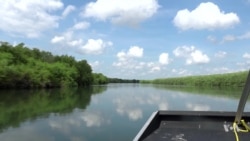President Donald Trump’s promised U.S.-Mexico border wall could trigger a budget showdown when Congress returns in September, as Democrats, and some Republicans, debate whether beginning construction on new sections of the wall would be worth the $1.6 billion expense.
But 2,700 kilometers away from Capitol Hill, in the varied border terrain of Del Rio, Texas, law enforcement and residents alike say the issue is even more complicated than is understood in Washington.
The terrain in the 64,000 square kilometers of the U.S. Border Patrol’s Del Rio sector can change dramatically kilometer by kilometer. Out on the Rio Grande, the river border between the United States and Mexico, the depth of the water can change day by day.
“It’s very shallow,” says U.S. Border Patrol agent Cory Maddox, on an air boat skimming over a river brought low in August heat. “It’s very simple to get to the river on the Mexican side."
Air boat patrols keep to the U.S. side, speeding past Mexican fisherman standing in thigh-deep water.
Maddox has watched undocumented immigrants use every way possible to cross this river. “They’ll use rafts, they’ll use horses,” he says. “Inner tubes. People just swim.”
Most are led by smugglers who know the best spots to cross the river, beating well-worn paths through the thick carrizo cane growing on the banks.
“These guys have been doing this for a long, long time,” Maddox says. “They know the places to cross.”
The Border Patrol uses the high bluffs above as a strategic viewpoint to track crossings. But their work is complicated by the invasive Carrizo cane below, which creates a dense thicket up to 7 meters tall and hides anyone approaching an existing 3-kilometer-long border fence.
“It can be creepy at night because you don’t see the person you’re trying to arrest, you don’t know if they’re good people or dangerous people,” Maddox says.
Out in the canyons
The Rio Grande River is just one of the areas Border Patrol agents cover in this sector.
It’s the canyons and kilometers of desert reaching temperatures of 43 degrees (Celsius) in the summer that complicate the debate over building a wall. Rep. Will Hurd, a member of Trump's Republican party whose district includes the most kilometers of U.S.-Mexico border of any member of Congress. He argues those natural barriers make building a continuous physical wall an expensive proposition.
“It’s not a one size fits all border,” says Matthew Hudak, acting Del Rio sector chief at U.S. Border Patrol. “What is that right mix in one area may not be the right mix even a short distance away.”
Hudak says the problem of border security is best solved with an approach mixing infrastructure, technology and personnel. The 2.7 kilometers of existing fence in Del Rio assist agents by slowing down undocumented crossings, giving them more time to respond. But he adds, “even with infrastructure, it’s going to be a personnel-intensive area to patrol.”
The funding passed by the U.S. House of Representatives in late July that will likely face a tough road to passage in the U.S. Senate adds funding for technology as well as $100 million to hire and train 500 additional U.S. Border Patrol agents.
A local perspective
But that varied terrain in the Del Rio sector changes the border wall debate from a local perspective.
“In my county, I don’t think we need a border wall,” says Val Verde County Sheriff Joe Frank Martinez, whose area of responsibility includes Del Rio.
Martinez, a member of the opposition Democratic Party, says he respects the position of President Trump, but he would like to see him experience the reality of life on the border beyond brief demonstrations.
“He needs to come down here and set foot on the border,” Martinez says. “People need to step foot on the border, people that are talking, need to know what they’re talking about.”
It’s a reality the president understands, says Lee Weathersbee, a retired rancher and former Del Rio city council member, who has lived along the border his whole life.
“If the guy’s got enough sense to make a $9 billion empire to build a building in downtown New York,” says Weathersbee, “He’s got enough sense where to build a wall.”











